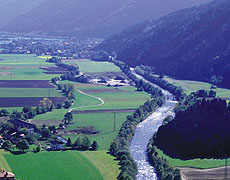 |
| Working together with the public to discuss concepts and develop a vision for the Möll River |
The EU Water Framework Directive (WFD) provides a regulatory framework for the protection of freshwater designed to ensure "good status” for all waters. All necessary measures are to be developed and implemented in an economic manner within an integrated restoration programme and by ensuring the involvement of the public.
In the mentioned research project, the Möll River is used as a model to define the vision for the river from both an ecological and socio-economic points of view, specify the requirements for good ecological status, evaluate the current status of the river and design a restoration programme.
Human intervention undermines the Möll River water quality
 |
| Results of the workshops were made accessible to the public in the form of a folder |
The Möll River is an alpine stream in Austria's province of Carinthia, originating from the mountains of the Hohe Tauern. After 90 km, it flows into the Drava (Drau), the main tributary of the Danube in Croatia. Today the Möll River is characterised by diverse human use. In the 1960-70s the river was systematically channelised and its banks were stabilized, which completely changed its morphological character. Moreover, a series of hydropower stations were constructed, causing two large impoundments, long stretches with water abstraction as well as hydropeaking and reservoir flushing. These factors, along with the intensive use of the valley, caused the river to be classified as "moderate” to "poor status” according to the WFD.
Guiding visions and river restoration measures
In order to improve the ecological status of the river and the surrounding landscape as a living space for the inhabitants of the Mölltal (Möll valley), a management programme was developed. To start with, an interdisciplinary team defined the ecological reference conditions that the management programme should meet.
Public participation
The next step in the project was to develop - in co-operation with the inhabitants of the Mölltal - a vision for the river and its floodplains by taking into account social and economic considerations.
Workshops were organised in the Mölltal and the communities' key persons, stakeholder groups and associations were asked to formulate their visions and goals which were then discussed and finally published in the "Leitbild Mölltal” folder. Government authorities, representatives of the hydropower agencies and the local planning consultants were also interviewed and their input was precious in further discussions about wishes and notions concerning the planning process and the specific management scenarios.
 |
 |
| The situation of the channelised river bed before ... ... and after restoration measures (visualisation) | |
The management scenarios developed for the Möll River include morphological river restoration measures, reforestation of the floodplain, increase of water discharge, lowering of hydropeaking (reduction of unnatural, short-term discharge peaks followed by extreme low water situations due to reservoir), and concepts to minimise reservoir-flushing impacts.
The outcome of the project is a vision for the future management of the Möll River, which has been developed based on ecological and socio-economic considerations, including the interested public in an active dialogue. We hope that the methodology developed through this model project will guide various other efforts to implement the EU Water Framework Directive.